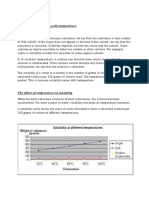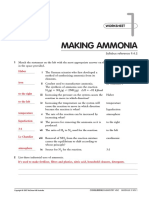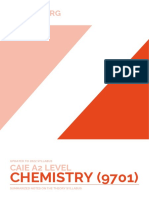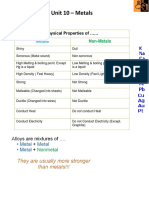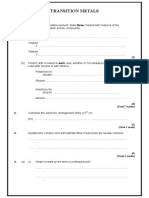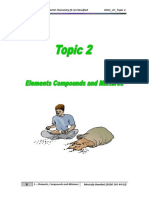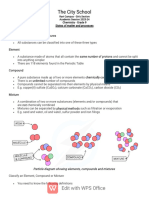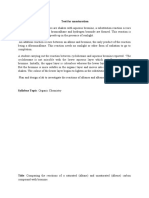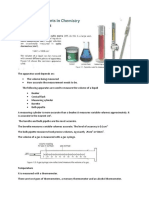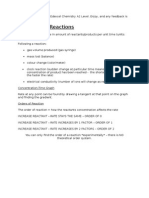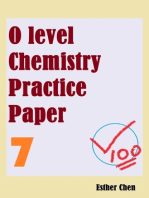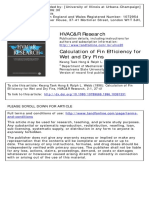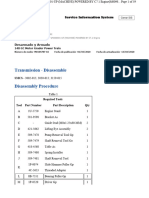Empirical and Molecular Formulas Worksheets
Empirical and Molecular Formulas Worksheets
Uploaded by
Naeem MuhammadCopyright:
Available Formats
Empirical and Molecular Formulas Worksheets
Empirical and Molecular Formulas Worksheets
Uploaded by
Naeem MuhammadCopyright
Available Formats
Share this document
Did you find this document useful?
Is this content inappropriate?
Copyright:
Available Formats
Empirical and Molecular Formulas Worksheets
Empirical and Molecular Formulas Worksheets
Uploaded by
Naeem MuhammadCopyright:
Available Formats
Empirical and Molecular Formulas The empirical formula of a compound gives the simplest whole number ratio of different
types of atoms in the compound. All salt formulas are empirical formulas. On the other hand, the molecular formula of a compound may or may not be the same as its empirical formula. For example, the molecular formula of butane is C4H10 while its empirical formula is C2H5. The molecular formula gives the true number of each kind of atom in a molecule. Empirical formulas may be easily determined from experimental data. Usually you must first determine how many grams of each type of atom are in the compound. If percent composition data is given, assume that you have 100.0 g of the compound; then the number of grams of each element is equal to the percentage for that element. The next task is convert the grams of each element to moles of the element. Be sure to keep at least three significant figures in your answers. The final step is to write the molar amounts of each element as subscripts in the formula. Then divide all molar subscripts by the smallest value in the set. At this point, the subscripts may all be very close to whole numbers; if so, you are finished. If one (or more) of the subscripts is not close to a whole number, multiply all molar subscripts by the simple factor which makes all subscripts whole numbers. Once the empirical formula is determined, the molecular formula is easily found if the molar mass (molecular weight) of the molecule is also known. You first calculate the molar mass of the empirical formula. Then you divide the molar mass of the molecule by the molar mass of the empirical formula. The division should give a simple whole number. That number is the factor by which all subscripts in the empirical formula must be multiplied to obtain the molecular formula. ______________________________________________________________________________ Exercises 1. The molecular formula of the antifreeze ethylene glycol is C2H6O2. What is the empirical formula? ______________________________________________________________________________ 2. A well-known reagent in analytical chemistry, dimethylglyoxime, has the empirical formula C2H4NO. If its molar mass is 116.1 g/mol, what is the molecular formula of the compound? ____________________________________________________________________________ 3. Nitrogen and oxygen form an extensive series of oxides with the general formula NxOy. One of them is a blue solid that comes apart, reversibly, in the gas phase. It contains 36.84% N. What is the empirical formula of this oxide? ______________________________________________________________________________ 4. A sample of indium chloride weighing 0.5000 g is found to contain 0.2404 g of chlorine What is the empirical formula of the indium compound? ______________________________________________________________________________ Answers: 1. CH3O 2. Molar mass of empirical formula is 58.06 g/mol. Thus molecular formula is C4H8N2O2. 3. The ratios are N1.00O1.50 . Since 1.50 is not close to a whole number, we multiply both subscripts by 2. The empirical formula is thus N2O3. (The name is dinitrogen trioxide.) 4. InCl3. 1
You might also like
- HalogenoalkanesDocument3 pagesHalogenoalkanesapi-504683923No ratings yet
- Unit 11 Gas Worksheet 3 Molar Volume and Gas Stoichiometry 2010Document1 pageUnit 11 Gas Worksheet 3 Molar Volume and Gas Stoichiometry 2010GeorgeNo ratings yet
- Chemistry Handout How Solubility Changes With Temperature SolubilityDocument16 pagesChemistry Handout How Solubility Changes With Temperature SolubilityAnderson MichelleNo ratings yet
- Making Ammonia: WorksheetDocument4 pagesMaking Ammonia: WorksheetckNo ratings yet
- Catapult Project OutlineDocument3 pagesCatapult Project Outlineapi-294483847100% (1)
- Caie A2 Level Chemistry 9701 Theory v1Document33 pagesCaie A2 Level Chemistry 9701 Theory v1Stefan BiehlerNo ratings yet
- 2023 2025 Syllabus Removed RemovedDocument34 pages2023 2025 Syllabus Removed RemovedDOMS XNo ratings yet
- Element PowerPoint Project 2Document4 pagesElement PowerPoint Project 2Jakierius GloverNo ratings yet
- Electrolysis of Lead Bromide and BrineDocument13 pagesElectrolysis of Lead Bromide and Brinesondos tawfiqNo ratings yet
- IGCSE Unit 10 ExtractionDocument17 pagesIGCSE Unit 10 ExtractionIsuriy AdasuriyaNo ratings yet
- Nuclear DecayDocument68 pagesNuclear DecayVaggelis KøtrønisNo ratings yet
- Transition MetalsDocument7 pagesTransition MetalsLearn With SaadiNo ratings yet
- Acids and Bases NotesDocument10 pagesAcids and Bases NotesThaarvena RetinaNo ratings yet
- 2 - Elemetns, Compounds and MixturesDocument12 pages2 - Elemetns, Compounds and Mixturesmostafa barakat100% (1)
- Electrolysis of Aqueous Solution: RevisionDocument7 pagesElectrolysis of Aqueous Solution: RevisionAzie Nurul AkhtarNo ratings yet
- Redox ReactionsDocument29 pagesRedox ReactionsSoniaAlexNo ratings yet
- Grade 9-Chem. Elements, Compounds and MixturesDocument5 pagesGrade 9-Chem. Elements, Compounds and MixturesMusfira zaibNo ratings yet
- Alkanes SlideDocument14 pagesAlkanes Slidevictoryayapaye147No ratings yet
- Chemistry Unit 4 Notes: 4.1 Rates of ReactionsDocument36 pagesChemistry Unit 4 Notes: 4.1 Rates of ReactionssarawongNo ratings yet
- Topic 5 - 'Stoichiometry'Document28 pagesTopic 5 - 'Stoichiometry'Nayeem HakimNo ratings yet
- Test For UnsaturationDocument3 pagesTest For UnsaturationJanaye IfillNo ratings yet
- Cie Igcse Physics Chapter 1 2023 OnwDocument24 pagesCie Igcse Physics Chapter 1 2023 OnwZeinab ElkholyNo ratings yet
- IGCSE Chemistry ElectrolysisDocument5 pagesIGCSE Chemistry ElectrolysisdanielmahsaNo ratings yet
- Isothermal Titration Calorimetry: Presented By: Ms. Prajakta S.Pawar. Guided byDocument54 pagesIsothermal Titration Calorimetry: Presented By: Ms. Prajakta S.Pawar. Guided byVrushali Puranik-GokhaleNo ratings yet
- Chem Energetics TestDocument7 pagesChem Energetics TestJkaurbhsNo ratings yet
- A2 ChemDocument81 pagesA2 ChemJana Mohamed100% (1)
- Chemistry o Level NotesDocument11 pagesChemistry o Level NotesThaboooNo ratings yet
- Chem s1 Notes BbernDocument93 pagesChem s1 Notes BbernSanjeefKumrIINo ratings yet
- AS Chemistry Revision Seminar 9701Document32 pagesAS Chemistry Revision Seminar 9701Jhoshna MuniandyNo ratings yet
- Cambridge IGCSE Chemistry Topic 7: Chemical ReactionsDocument3 pagesCambridge IGCSE Chemistry Topic 7: Chemical ReactionsayaanNo ratings yet
- AS Level Chemistry - Unit 1 Revision GuideDocument16 pagesAS Level Chemistry - Unit 1 Revision GuideJoel Biffin100% (1)
- Chapter 6 ElectrochemistryDocument11 pagesChapter 6 ElectrochemistryAshraf Shaharudin100% (1)
- Atomic StructureDocument30 pagesAtomic Structurenaeem mushtaqNo ratings yet
- N-Levels: 2014 Chemistry Notes For Secondary School Combined ChemistryDocument44 pagesN-Levels: 2014 Chemistry Notes For Secondary School Combined ChemistryAnnie Tan100% (1)
- AS Level Chemistry Practical Paper 3: TitrationDocument12 pagesAS Level Chemistry Practical Paper 3: TitrationAbrar ShariarNo ratings yet
- Chemical Energetics: Igcse ChemistryDocument12 pagesChemical Energetics: Igcse ChemistrySherly LeticiaNo ratings yet
- IGCSE Chemistry Section 5 Lesson 3Document43 pagesIGCSE Chemistry Section 5 Lesson 3Bhawana Singh100% (1)
- Reactions-Of-Acids-2 WorksheetDocument1 pageReactions-Of-Acids-2 WorksheetSuju SonNo ratings yet
- A Level Chemistry Notes Physical ChemDocument47 pagesA Level Chemistry Notes Physical ChemSolomon MuwandiNo ratings yet
- Naming Compounds Hand OutDocument12 pagesNaming Compounds Hand OutPriscilla KellyNo ratings yet
- Some Tips For Chemistry ATPDocument3 pagesSome Tips For Chemistry ATPAbdul HannanNo ratings yet
- Unit 4 Chemistry A2 NotesDocument37 pagesUnit 4 Chemistry A2 NotesminayokiNo ratings yet
- IGCSE Chemistry S1 L1Document116 pagesIGCSE Chemistry S1 L1Antonia Putri Sri Nova YolandhaNo ratings yet
- Chapter 12 Experimental Techniques and Chemical AnalysisDocument26 pagesChapter 12 Experimental Techniques and Chemical AnalysisnothingisfingnothingNo ratings yet
- Chemistry Edexcel Unit 2 AsDocument18 pagesChemistry Edexcel Unit 2 Asminayoki0% (1)
- Chemistry Edexcel As Keywords Unit 1Document4 pagesChemistry Edexcel As Keywords Unit 1Ashan BopitiyaNo ratings yet
- As Topic 4 Notes - Bonding & PeriodicityDocument8 pagesAs Topic 4 Notes - Bonding & PeriodicityJoyce LimNo ratings yet
- IGCSE ChemistryDocument25 pagesIGCSE ChemistrygeminisignNo ratings yet
- AS'Level EDEXCEL Chemistry Chapter#2.2Document2 pagesAS'Level EDEXCEL Chemistry Chapter#2.2MehreenSaeedNo ratings yet
- Notes and Questions: Aqa GcseDocument18 pagesNotes and Questions: Aqa Gcseapi-422428700No ratings yet
- As Chemistry Unit 2 NotesDocument21 pagesAs Chemistry Unit 2 NotescluendoNo ratings yet
- Atomic Structure PDFDocument9 pagesAtomic Structure PDFPoojal BatraNo ratings yet
- PhysicssDocument4 pagesPhysicssmozajNo ratings yet
- IGCSE Chemistry Revision Notes SampleDocument1 pageIGCSE Chemistry Revision Notes SampleAbdelmoneim Elmansy IgcseNo ratings yet
- TH He Total 7 Chemactive ComDocument10 pagesTH He Total 7 Chemactive ComNavNo ratings yet
- Chapter 6 - Chemical Bonding, Structure and PropertiesDocument10 pagesChapter 6 - Chemical Bonding, Structure and PropertiesAdil Yaqub - 74665/TCHR/CNTBNo ratings yet
- Oil Burner Controls Type BHO 64 and LOA 44 - DanfossDocument12 pagesOil Burner Controls Type BHO 64 and LOA 44 - Danfossr_cristiNo ratings yet
- SteeringPt1 04Document22 pagesSteeringPt1 04Neo ZaoNo ratings yet
- CH 12 Electricty and Circuit 2Document29 pagesCH 12 Electricty and Circuit 2POOJA SUSHILNo ratings yet
- Boots StarDocument1 pageBoots StarFox FoxNo ratings yet
- CRSI Manual To Design RC Diaphragms - Part3Document4 pagesCRSI Manual To Design RC Diaphragms - Part3Adam Michael GreenNo ratings yet
- Id 009Document8 pagesId 009nenad lazicNo ratings yet
- SAPS - Bubbling Pondweed - Teaching NotesDocument6 pagesSAPS - Bubbling Pondweed - Teaching NotesAliciandra GrantNo ratings yet
- Recap ThermalDocument8 pagesRecap ThermalGunnerZedNo ratings yet
- CPRA 1250i + SAW Tractor CPRA: Compact and Heavy Duty SAW SystemsDocument2 pagesCPRA 1250i + SAW Tractor CPRA: Compact and Heavy Duty SAW SystemsSadashiva sahooNo ratings yet
- Worksheet EPAS 11 W3 JainDocument3 pagesWorksheet EPAS 11 W3 JainAllan Gilbert Manalo JainNo ratings yet
- Calculation of Fin Efficiency For Wet and Dry Fins.Document16 pagesCalculation of Fin Efficiency For Wet and Dry Fins.Wilfredo Ruiz100% (1)
- 70cm Quadruple QuadDocument5 pages70cm Quadruple QuadJosé Antonio Miranda100% (1)
- Pt. Multikarya Sarana Perkasa Pt. Kutai Refinery Nusantara: Loading & Install Eqipment RG Plant Loading EquipmentDocument3 pagesPt. Multikarya Sarana Perkasa Pt. Kutai Refinery Nusantara: Loading & Install Eqipment RG Plant Loading Equipmentrizky youlandaNo ratings yet
- MME B.Tech IV-SEM REG MR-21 Model-Question-PapersDocument10 pagesMME B.Tech IV-SEM REG MR-21 Model-Question-Papersankit pandeyNo ratings yet
- Chlodnice Oleju CSL CiesseDocument28 pagesChlodnice Oleju CSL CiesseCARLOS RAMIREZNo ratings yet
- 140 GC MOTOR GRADER W92 Transmission - DisassembleDocument59 pages140 GC MOTOR GRADER W92 Transmission - DisassembleJaime MurilloNo ratings yet
- Mechanical SpringsDocument25 pagesMechanical SpringszerihunyedawitNo ratings yet
- Cable Size CalculationsDocument4 pagesCable Size Calculationsgaurav_chikhalkar007No ratings yet
- MODULE1 AlternativeResourcesDocument7 pagesMODULE1 AlternativeResourcesCharlie SumagaysayNo ratings yet
- Quantum Random Ip - Op and Its Applications in Random Frequency Synthesis and True Random Number GenerationDocument10 pagesQuantum Random Ip - Op and Its Applications in Random Frequency Synthesis and True Random Number GenerationRam RajaNo ratings yet
- Mathematics: Daily Practice ProblemsDocument2 pagesMathematics: Daily Practice Problemsmanoj sharmaNo ratings yet
- 37mm (1.4 INCH) 5x8 SINGLE COLOR DOT Matrix Displays: Mechanically RuggedDocument5 pages37mm (1.4 INCH) 5x8 SINGLE COLOR DOT Matrix Displays: Mechanically RuggedStuxnetNo ratings yet
- Lecture2 Homework BIO1401 Sp23Document8 pagesLecture2 Homework BIO1401 Sp23wafae moutanaNo ratings yet
- Density Revision Worksheet SA2B 2020-21Document4 pagesDensity Revision Worksheet SA2B 2020-21Vedant NavaniNo ratings yet
- FINAL Checklist JEE Mains 2024 Neha AgrawalDocument5 pagesFINAL Checklist JEE Mains 2024 Neha Agrawalaarushd3391No ratings yet
- Phet Online Lab Conductors and Insulators1Document2 pagesPhet Online Lab Conductors and Insulators1Michelle CenNo ratings yet
- ASME II Part ADocument5 pagesASME II Part AJOOSENo ratings yet
- Fluid Mechanics Fundamental ConceptsDocument22 pagesFluid Mechanics Fundamental Conceptshandoutsonline58No ratings yet
- Physics Investegatory ProjectDocument20 pagesPhysics Investegatory Projectjayalakshmanv46No ratings yet
- Magnetic Characteristics For Mu-Metal ENNI75-020 Core (002) 1Document2 pagesMagnetic Characteristics For Mu-Metal ENNI75-020 Core (002) 1gfgfgNo ratings yet


